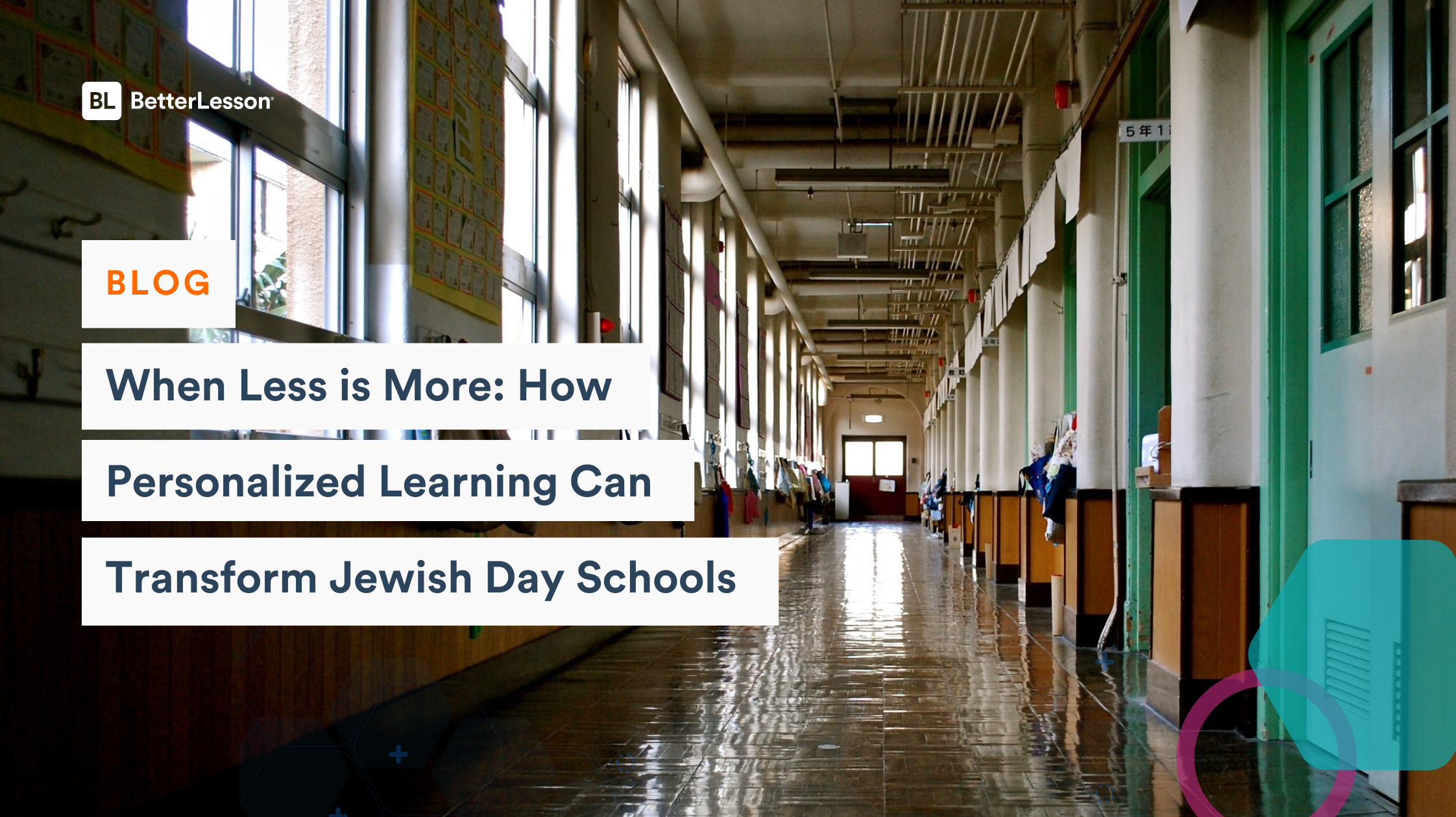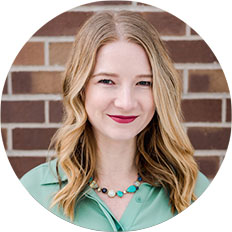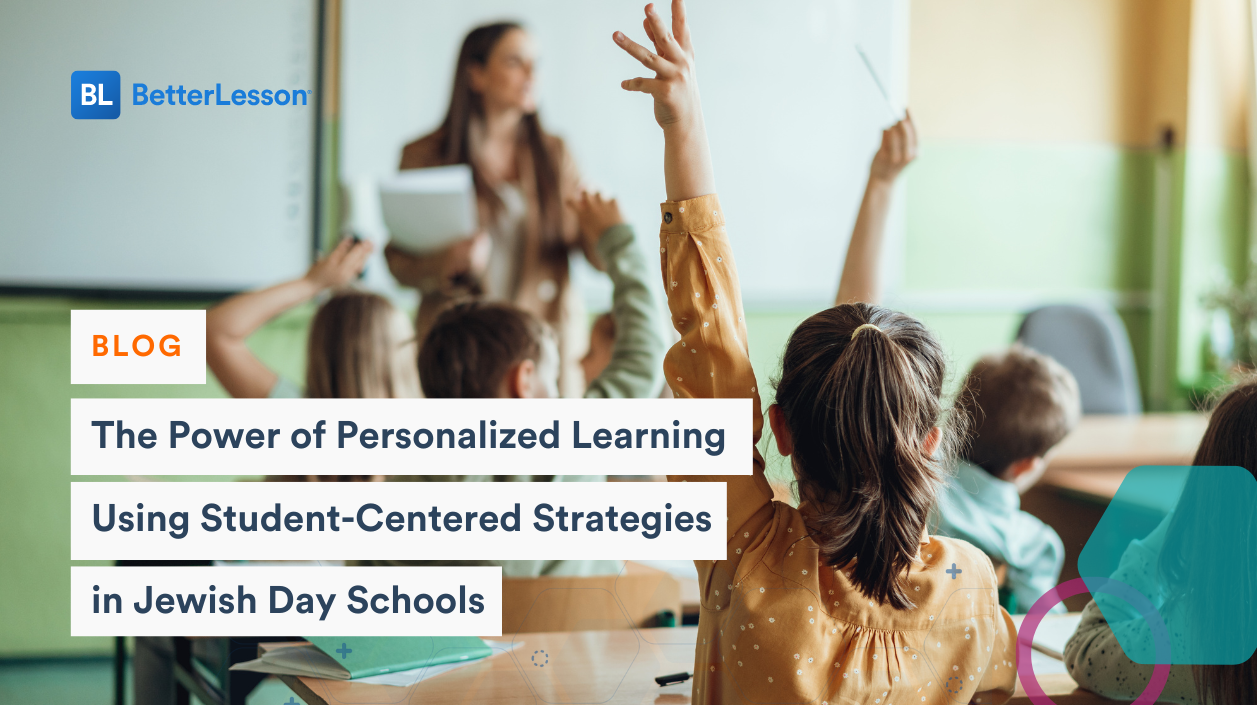Every school is different and has its unique challenges. Jewish Day Schools are unique as they bring the warmth and consistency of Jewish values and the power of deep learning to students. However, covering both Judaic and General Studies in one day brings challenges. Additionally, Jewish Day Schools follow the Jewish calendar and celebrate Jewish holidays, which means time out of the classroom. Students have a lot of learning to do, and teachers have less time to teach it. However, less can be more! The key is quality teaching and learning.
So, how do we ensure quality teaching and learning? The answer is personalized learning using student-centered strategies grounded in the five pillars.
What is personalized learning?
Personalized learning isn’t necessarily creating a personalized plan for each student (that would be a lot of work!), but it is understanding the uniqueness of each of your students and their strengths and gaps. It’s about creating a foundation for student ownership through personalized pathways students can take using key structures and systems.
At BetterLesson, we believe five key pillars are at the heart of personalizing student growth in the classroom and can be especially transformative in Jewish Day Schools. These are:
- Classroom culture: How can I support student relationships?
- Grade-level content: How can I prioritize key skills and content?
- Scaffolds & supports: How can I use UDL principles to meet the needs of all students?
- Tech supplements: How can I leverage tech tools to create a sustainable system?
- Mastery-based assessments: How can I prioritize depth over breadth?
After teaching and leading a team of teachers at a Jewish Day School through BetterLesson the following ideas and strategies have transformed their classrooms.
How are these pillars applicable to Jewish Day Schools?
Classroom Culture
Challenge: Classroom culture is about creating a safe and supportive environment for every learner. To cultivate the other pillars, a strong classroom culture is required. In a Jewish Day School, this can be challenging with less time in the classroom for each subject and several Jewish holidays and events impacting class time.
Solution: By using quick, simple, and effective strategies to get to know our students and their families, we can better understand how to support each student.
Thresholding to Greet Students at the Door helps create that culture right at the start of class, even before students enter the classroom! One elementary science teacher at a Jewish Day School in New York loved this strategy, as she shared, “I think the most impactful student-centered tool I’ve learned (through coaching) has been greeting students at the door before class. It reminds them that a teacher is in the room and they need to walk in ready for class. Also, I get to see the smiles on their faces when they come in.”
Other strategies to help:
- Strengths Based Instructional Practices: This is a great way to receive input from your students about their strengths and needs to help them set goals.
- Teaching Perseverance in Math: To strengthen classroom culture, we can teach our students the necessary social-emotional skills to help them be successful in their learning, such as perseverance and resilience.
- Creating and Implementing a Family Partnership Plan: By creating a plan with families, you can better understand where families are coming from and their values and expectations about school. Families choose Jewish Day Schools for a reason, so this plan can help you ensure that you partner with families to build a plan centered on trust and the student’s learning needs.
Grade-Level Content
Challenge: One challenge in Jewish Day Schools is the shorter time spent in each subject area. Therefore, prioritizing key skills and content is especially important!
Solution: Jewish Day School Educators can plan out unit and lesson plans that clearly lay out key skills to create personalized pathways for students to master those skills.
I have seen success with Jewish Day School educators using learning targets to guide instruction and learning target self-assessments that help students take ownership of their learning and know their path.
Other strategies to help:
- Backwards Design: When backwards planning, teachers first identify the skills and content that students should master by the end of a unit or module and then work “backwards” from there to outline the learning pathway to get there.
- 3-2-1 to Activate Knowledge, Reflect, and Self-Assess: This was one of my favorite quick and simple ways to gauge where students are with key skills and content at the end of a lesson or unit!
Scaffolds & Supports
Challenge: Students come to Jewish Day Schools from all different backgrounds and are at various academic levels. How do we prioritize key skills when students are all at different levels? When coaching Jewish Day School educators, in addition to time, supporting a diverse set of students in both General and Judaic Studies is often the number one challenge I hear.
Solution: When we outline the clear grade-level skills and standards we want to cover, we can then put scaffolds and supports in place to help students get there.
So many flexible, student-centered, and personalized learning strategies allow students to progress at their own pace and work on key skills they need to master. Here are some of the most common strategies I have seen many Jewish Day School educators find success with:
Choice Boards: The power of choice boards is that they give students ownership and choice over their learning, while giving the teacher time to differentiate, observe, and assess in real-time. My students LOVED choice boards and asked that we do them over and over again!
When asked about some of her favorite student-centered strategies, Rochelle Einhorn, a Second Grade General Studies Teacher at Yavneh Academy in New Jersey, shared: “In our space unit, choice boards enable my students to learn on their terms. They can choose to broaden or deepen their knowledge depending on the tasks they choose to do. Creating the choice board helped me find a way to reach my students with their strengths by suggesting a variety of activities. They are so excited to see science on the schedule! They will often approach a classmate or me to show or tell something cool they discovered. It also sparks thoughtful questions for them to research and discuss.”
Here are two examples of Choice Boards created and used by Rochelle Einhorn:
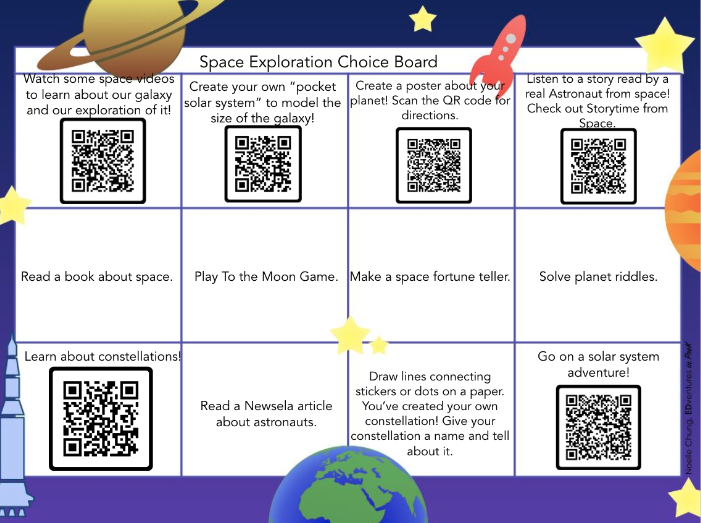
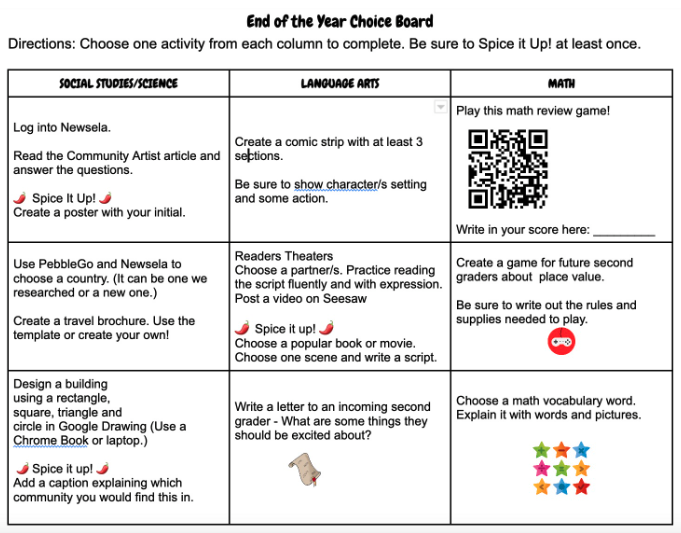
Another favorite is the end-of-the-year choice board. The students can choose ways to showcase their learning in meaningful ways to them. The students can choose the subject area and modality they find most appealing. I love seeing the games and letters they come up with!
Rochelle Einhorn, a Second Grade General Studies Teacher at Yavneh Academy in New JerseyMild, Medium, Spicy Strategic Grouping is another flexible strategy that gives students flexibility, choice, and support! It gives three personalized pathways to practice a skill or standard depending on the level of support or challenge needed. This fits well in a shortened Jewish Day School classroom with students at all different levels. It’s also fun!
An example of a Mild, Medium, Spicy board created by Alex Weisz, a Jewish Studies Teacher at the Jewish Day School of Metropolitan Seattle. In a coaching call, he stated that the structure and ability to reach kids on all levels was helpful.
Other strategies to help:
- WIN (Whatever I Need) Time: This is a fun and flexible way to differentiate and support students in taking ownership of their learning goals. Students choose to work on skills they need more practice in, and the teacher can use this time to pull students for more support. WIN could be done daily or weekly, or as needed! This was one of my favorite systems that I used in my own General Studies classroom.
Tech Supplements
Challenge: The previous pillars require teachers to be flexible and creative in their planning to reach all students. That can be challenging!
Solution: Tech tools can bring these flexible and personalized systems to life! With online games and other online learning platforms, students can progress at their own pace and learn skills with targeted support.
Tech Tool Ideas:
- Learning Platforms/Systems: iReady and IXL give students differentiated content.
- Digital Reading Passages: Newsela gives students engaging reading passages on the same topic, but at different lexile levels.
- Discussion Tools: Google Jamboard, Flip, and Padlet allow students to communicate digitally and share their ideas.
- Quiz/Assessment Tools: Student response systems like Quizziz and Kahoot make quizzes feel like a game!
These asynchronous tools pair nicely with a flexible learning system, such as a choice board, WIN time, or mild, medium, spicy!
While reflecting on one of our final coaching calls, Alex Weisz, a Jewish Studies Teacher at the Jewish Day School of Metropolitan Seattle, stated, “I now know that asynchronous tools are powerful tools in a blended classroom!”
Mastery-Based Assessments
Challenge: With shortened classes and Jewish holidays, schedules can sometimes feel disjointed and cause teachers to want to cover various topics when they can. However, In order to prioritize key skills and content and support student needs, we have to focus on depth over breadth for student growth.
Solution: Mastery-based assessments are a culmination of all the other pillars. In order to put mastery-based assessments into action, we need a classroom culture where students feel safe and supported to progress and show what they know about a topic, skill, or standard at their own pace as well as self-assess their strengths and areas of growth. Mastery-based assessments focus on key grade level skills/content and may even utilize tech tools to assess. With the right scaffolds and supports in their learning journey along the way, students can feel confident and ready to master the skill/standard being assessed.
Strategies to help: Here are some powerful ways that Jewish Day School educators have helped students own their learning journey and assess where they are towards a standard:
- Marzano Self-Assessment: Give students a clear and simple way to self-assess where they are!
- Student Conferences with Teacher: This is another flexible way to give students one on one support and help them to own their learning journey! My students loved taking ownership of their own data in these conferences in order to set goals!
- Students Become Teachers to Demonstrate Mastery: A great way to see if students understand a skill is to have them teach it to their peers!
How can coaching help Jewish Day School Educators?
Personalized learning strategies are not always easy to implement at first. They require a shift from traditional teaching and learning models to be carried out effectively. This is where getting support from an instructional coach can be powerful!
One elementary science teacher at a Jewish Day School in New York shared how coaching has impacted her: “Coaching has equipped me with tools to better culminate a student-centered learning environment. Coaching has helped me focus and organize my ideas and actually implement them. Also, it has just been a relief to know that there is always someone there to help me teach or just talk through things. Since coaching started, I learned what kind of teacher I want to be. I think I’m getting there. I have learned what values I see in my role as a teacher and how I can help my students reach their potential. I learned that there are good days and there are bad days. But at the end of the day, the classroom I create has the power to change a student’s day. So no matter what, all of this effort will be worth it.”
By focusing on the five pillars: classroom culture, grade level content, scaffolds & supports, tech supplements, and mastery-based assessments, Jewish Day School educators can ensure that they are teaching key skills, helping students take ownership of their learning, and creating a classroom and school culture that is safe, supportive, and empowering. Ultimately, this paves the way for students to be lifelong learners. If you are interested in shifting to student-centered learning using personalized learning strategies, a BetterLesson coach can help!
